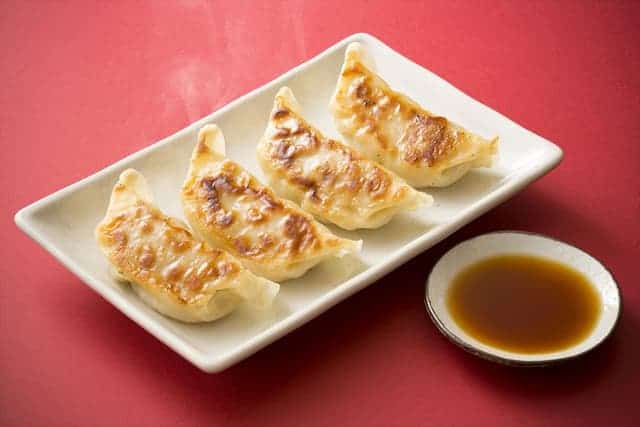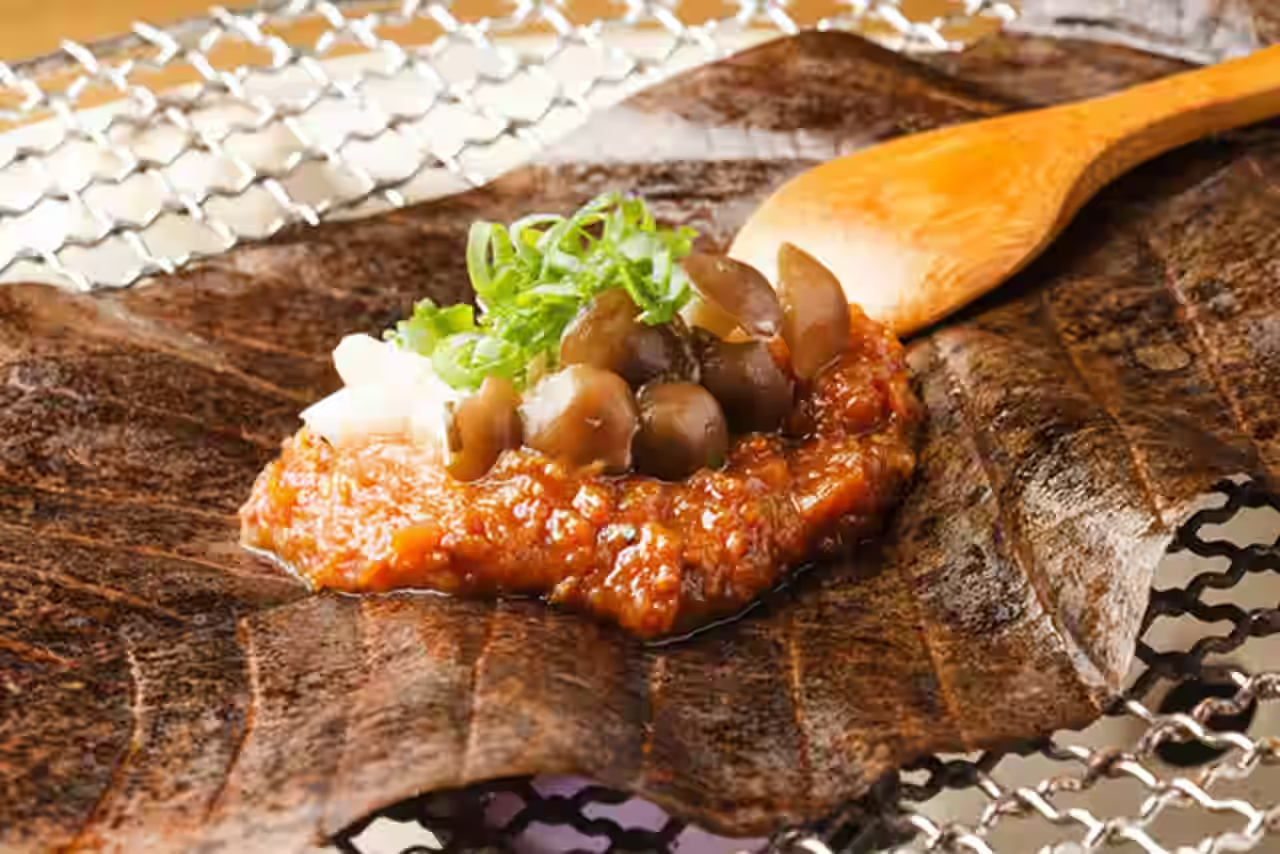Mentioning Japanese food, you may think of ramen, sushi, okonomiyaki, takoyaki, etc. Other than these famous dishes, Japanese cuisine has so many distinctive and delicious food that you can not find anywhere else in the world. Today, in this article, we are going to introduce Gyoza (餃å), Japanese pan-fried dumplings. Let’s find out what is special within this dish, how to make and where to taste this mouthwatering food in Japan!
What is Gyoza?

Gyoza (餃å) (also known as jiaozi in Chinese) is Japnese dumplings with fillings of vegetables, cabbage, meat and wrapped by a piece of dough. There many ways of cooking dumplings such as boiling, steaming, frying or grilling. Even in Japan, except from normal dumplings, some places also have their local specialities. Gyoza is so loved by Japanese that there is even a “competition” between city on Gyoza consumption per year. Hamamatsu and Utsunomiya have been long known as “Japanese dumplings capital” in Japan. However, in January 2021, Miyazaki has beated these two perpetual cities to take the first place for the first time in history.
History of Gyoza
Many Japanese people often eat dumplings as a main dish, some even eat them on a daily basis, but not everyone knows the history behind this popular dish. In fact, each country has its own history of dumplings, and the culture of gyoza in each country is different! Therefore, we will explain in detail the beginning of this dish in both China and Japan.
The origin of dumplings in China
Theory about the ancient dumpling
As most of us have known, gyoza originated from China and then was introduced to Japan later and become one of the most favourite in Japanese table. If you search on the internet, there are various theories about the birth of dumpling. However, according to the “Kikkoman Institute for International Food Culture: 54th Food Culture Lecture“, the history is as follow:
In 5th century BC, China already had a culture of eating rice in stead of wheat. Wheat was fodder for livestock but not used as human food. This is because rice can be eaten by threshing while wheat have to be powdered to be edible. It is only after stone mills were introduced through the Silk Road in the 5th to 3rd century BC that the cultivation of wheat flourished and people began to eat them.
 It is not clear when dumplings began to be made and eaten, but a lot of people say that it might be around the Tang dynasty. Dried dumplings have been found in the ruins of Dunhuang, a city in China. It is almost the same as today’s gyoza, with the characteristics such as “folded in two”, “folded”, “semi-circular”, and “pointed”.
Souce of the lecture: https://www.kikkoman.co.jp/pdf/no27_j_012_013.pdf
Historical story about Zhang Zhongjing – father of dumplings
Besides, there are another story about the origin of these dumplings. According to one story, gyoza stem from Zhang Zhongjing, a master of Chinese medicine. One day on a cold day, he stopped by a small poor village, where villagers were suffering from frostbitten ears. Seeing this, he wanted to do something to help people there and decided to boil lamb meat, Chinese herbs, spices wrapped by wheat flour skin, which was then served to the villagers in a warm soup. Then, the villagers continued to eat them throughout the cold winter and by the New Year’s Eve, the frostbitten ears had been healed. Overtime, Zhang Zhongjing’s recipe was adapted and imitated by the people of China. It is such an interesting story to hear, right?!
Up until now, Chinese people has a custom of eating jiaozi on New Year’s day. This traditional custome began in the Ming Dynasty, when people used to wrap things (coins, silver coins, jewelry, etc) in dumplings and it was considered a symbol of good luck for the new year. In addition, the reading of gyoza “jiaozi” has the same sound as the word “jiazi”, which means to have children. That is the reason why dumplings are very popular and represent good luck and happiness in China.

Introduction to Japan
So how did gyoza come to Japan? Surprisingly, the history of this dumpling in Japan is quite old, dating back to the Edo period.
According to the Mito clan’s “Shu-Shunsui-shi danki” written by the Mito clan about Shu Shunsui, a Confucian scholar of Ming Dynasty, in 1689, dumplings made with duck meat called fukutsutsumi were presented to Mito Mitsukuni (Mito Komon). Based on this, it is generally believed that the first Japanese to eat gyoza was Mito Komon. By the way, Mito Komon is also said to be the first Japanese to eat ramen in Japan.
In the Meiji period, the ban on eating meat was lifted, and books introducing Chinese cuisine were published one after another, but there were not many things writing about gyoza. Even if there was appearance of dumplings in Japan at that time, most of them were steamed dumplings or boiled dumplings. It was only after World War II, when the soldiers came from China and brought together the recipe of Chinese jiazi that pan-fried dumplings became popular and became one of Japanese favourite street food. The very first gyoza shop after World War II is Yuraku in Shibuya (Tokyo) in 1948.
Although gyoza stemmed from China, when it came to Japan, this dish has evolved and become an unique Japanese-style food. While boiled dumplings are favourite food in China, Japanese prefer pan-fried gyoza or grilled gyoza. In Japan, garlic is more often used as ingredients and dumpling is commonly served with soy sauce or chili oil. However, Chinese people do not have the habit of eating dumplings with chili oil but normally using soy sauce.
Japan – the heaven of gyoza with many different types
The obsession of Japanese people with these poststickers cannot be denied at all. From just a simple dumpling, when coming to Japan, it has revolutionized and turned into various different kinds of gyoza. Each region has its own unique local dumplings, so it would be really nice to enjoy this delicious dish in many places when you go on a trip.
Enban Gyoza (Fukushima Prefecture)

This is a local dumpling in Fukushima. You can easily find restaurants around Fukushima Station. The characteristic of Enban gyozas is that they are arranged in a disc-shaped and fried with a small amount of oil.
Utsunomiya Gyoza (Tochigi Prefecture)

Utsunomiya is long known as one of the two best city in the competition of dumplings consumption. The signature of dumplings here is the light seasoning and vegetables are used much more than meat.
Click here to find out more about local gyoza in Utsunomiya.
Hamamatsu Gyoza (Shizuoka Prefecture)

Hamamatsu dumplings are famous for their sweetness of ingredients thanks to the use of onions along with vegetables. Another unique point is Hamamatsu gyoza is usually served with boiled bean sprouts.
Want to read more about Hamamatsu dumplings? Go here!
White Gyoza (Chiba Prefecture)

White dumplings are characterized by a slightly thick skin that wraps the fillings inside and is pan-fried in a large amount of oil to make it crispy.
Tsu Gyoza (Mie Prefecture)

The appearance is the thing that makes this dish unique from normal dishes. Dumplings are wrapped in gyoza wrappers with a diameter of 15 centimeters and then deep-fried. Compared to general dumplings, they are much bigger and the skin is crispy with juicy taste inside.
Kobe Gyoza (Hyogo Prefecture)

Kobe gyoza is dishtinguishable by its miso-based sauce. Each store has its own original miso-based sauce, which is the charm of Kobe dumplings! In addition, in Kobe, people have the habit of adding garlic, chili oil, and vinegar to the miso sauce, which includes red miso, white miso, and vinegar miso.
Tetsunabe Gyoza (Fukuoka Prefecture)

These dumplings are local specialies of Hakata city in Fukuoka Prefecture. You can enjoy eating in an iron skillet here without the fear of them getting cold when you haven’t finished the dish yet. Thanks to the hot iron pot, the dumplings have crunchy crispy texture and juicy fillings. The size is smaller than the normal one so that you can eat dozens of them.
Want to find some good restaurants serving Tetsunabe dumplings? Search here!
Sendai Aoba Gyoza

A bright green gyoza in Sendai city, Miyagi prefecture. It is made using green vegetables, a local specialty.
Shining Gyoza
This dish is the “modernized” version of traditional dumplings and takes inspiration from the dish “Cheese dakgalbi” from Korea. Just like cheese dakgalbi, pan-fried dumplings are arranged on both sides of a hot plate and then cheese is spread in the middle. That is the reason why this dish is called “shining gyoza”.
Macaron Gyoza

Speaking of macaron, you may think of something sweet but it is not like what you are thinking at all. The name “Macaron Gyoza” refers to dumplings with 9 different colored wrappers from a shop called “Daiho Gyoza”. The colorful skin is made from vegetable powder and squid while the fillings are ingredients such as bamboo shoots, plums, squid, etc.
Vegan dumplings

Vegan gyoza is Japanese vegetables dumplings. This dish is a great choice for vegetarians. Just from vegetables, there are many kinds of fillings of vegan gyoza that have been made. Thanks to this, you will never get bored of the dish in spite of the simple ingredients. Some ingredients are often used in vegan dumplings are soymeat, shiitake, cabbage, chives, green onion, etc.
How to make Japanese dumplings?

Ingredients for gyoza’s wrappers
| Ingredients | |
| Cake flour | 140g |
| Bread flour | 110g |
| Salt | 1/2 tsp |
| Boiled water | 170ml |
| Katakuriko (Potato starch) | moderate amount |
| Bean paste | moderate amount |
| Water (used for wrapping) | moderate amount |
Let’s making the wrapper!
- To begin with, mix the cake flour, bread flour and salt in a large bowl.
- Pour hot water and mix with chopsticks. When it becomes a minced ball, knead by hands for about 5 minutes.
- When the dough is elastic, shape into a ball and wrap it with a plastic wrap and leave at room temparature for about 15 minutes.
- Divide the dough into 3 equal parts and shape each part into a stick shape.
- Next, divide each stick dough into 12 equal parts (36 parts in total).
- Sprinkle potato starch on the entire surface and flatten each piece by crushing with hands. Use a rolling pin to roll out the dough into a thin circle (about 10cm thickness).
Finally, dip the wrapper in water, wrap it with your favorite bean paste. If you want to store the wrapper, keep it in the refrigerator for 3-4 days or in the freezer for a longer period of time (about 1 month).

Recipe for a classic gyoza
Ingredients
| Ingredients (for 4 people) | |
| Minced pork | 150g |
| Cabbage | 3 pieces |
| Chives | 5-6 |
| Dumpling wrapper | 1 bag (25-30 pieces) |
| Salt | 1/3 tsp |
| Salad oil | 1/2 tbsp |
| Sesame oil | 1 tsp |
| Garlic (chopped) | 1 piece |
| Ginger (chopped) | 1 piece |
| Wine | 1 tbsp |
| Soy sauce | 1 tbsp |
| Sugar | 1/2 tsp |
| Pepper | a little |
Ready to cook!
- Firstly, chop the cabbage finely and sprinkle with salt. When the cabbage becomes soft, squeeze out the water.
- Cut chives into small pieces (about 5mm).
- Next mix minced pork, cabbage and other ingredients in a big bowl.
- Next, when the mixture is done, place a wrapper in the palm of your hand, put a little amount of fillings in the center and fold the wrapper. Continue to do the same with the rest.
- Then add salad oil to the frying pan and fry the gyoza over medium heat. Add some water and cover the pan with a lid.
- When the water evaporates and the gyoza turns into golden brown and has crispy texture, it is the symbol that the dish is ready!
Lastly, serve the gyoza with vinegar, soy sauce or chili oil up to you favourite. You can also try with chilled drinks such as a cold beer for a refreshing taste!
Where to eat Gyoza?
In Japan, this dish is so famous that you can find it anywhere at restaurants, izakaya, etc. Today, we would like to introduce you some of the most famous gyoza shops as recommendations for your next meals!
Gyoza Bar Aoyama

This restaurant may be a little bit different from the normal traditional gyoza shop. It is a gyoza shop with French taste, suitable for wine and champagne. All the gyozas here are served with French-based sauces. You can enjoy many different types of gyoza with colorful sauces just like painters palette! Therefore, this place is really nice place for couples to date, or if you just want to experience a chill and romantic atmosphere, just come here!
Tiger Gyoza Kaikan Udagawacho (タイガー餃å会館 å››æ¡çƒä¸¸)

This place is famous for its juicy and chewy gyoza. Apart from the classic gyozas, you can also try other 14 unique types of gyoza of this restaurant. Surprisingly, there is even a collaboration with the popular work “Dorohedoro”, which allows you experience the dining room “Hungry Bug” and eat Caiman’s favorite food, “Ooba Gyoza”! If you are a fan of “Dorohedoro”, or if you want to have something new to experience, do not forget to note this restaurant in your to-eat-list!
GYOZAOH! Dotonbori Store

Looking for a good gyoza shop in Osaka? This option is definitely for you! Gyozaoh is a famous restaurant in Chuo, where they offer a lot kinds of gyoza, even vegetable gyoza for vegetarians. Although the menu is simple , the food here is very delicious and nice to try. The staff at the restaurant is really nice and friendly too.
Hanamaruken Namba Houzenji

Another popular restaurant in Osaka. Hanamaruken Namba Houzenji is commonly known as a ramen shop with the loved dish “Shiawase Ramen”, a tonkotsu soy sauce flavor that uses pork bones that have been slowly simmered for over 12 hours. However, the popularity of this restaurant’s gyoza can not be denied as it is always hand made and have the crispy texture and great combination of ingredients.
Takeaway

Gyoza is a very famous dish in Japan. You can enjoy it as a side-dish or even as a main dish. It is really easy to find gyoza at any restaurants too, but if you want to make gyoza by yourself, try our recipe at home. Nothing is better than a freshly made gyoza and don’t forget to eat them with your favourite choice of sauce!
If you want to find more about gyoza, find out here!















Comments